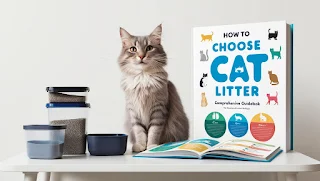Best Cat Litter: Finding the Perfect Match for Your Feline Friend
Choosing the best cat litter for your feline companion can be a daunting task, given the multitude of options available in the market. It's crucial to consider factors such as absorbency, odor control, dust levels, and ease of cleaning. The best cat litter should keep your home smelling fresh, be comfortable for your cat, and be easy for you to manage. Let's dive into the various aspects that make a cat litter the best choice for your furry friend.
Best Litter for Cats: Prioritizing Your Cat's Comfort and Health
The best litter for cats is one that prioritizes their comfort and health. Cats can be particular about their litter, and their preferences can vary widely. Some cats prefer fine-grained litters, while others might favor larger granules. Additionally, it's essential to consider any allergies or sensitivities your cat might have. Opt for a litter that is low in dust to prevent respiratory issues, and ensure it has good clumping properties to make cleaning easier. Ultimately, the best litter for your cat will be one that they are comfortable using consistently.
Natural Cat Litter: Eco-Friendly Options for a Greener Home
Natural cat litter is an excellent choice for environmentally conscious pet owners. Made from renewable resources such as corn, wheat, pine, or recycled paper, natural cat litter is biodegradable and often flushable. These litters are free from harmful chemicals and synthetic fragrances, making them safer for both your cat and the environment. Additionally, natural cat litter tends to have excellent odor control and absorbency, providing a pleasant experience for both you and your cat.
Types of Cat Litter: Understanding the Various Options Available
There are several types of cat litter available, each with its own set of advantages and disadvantages. The most common types include:
- Clumping Clay Litter: Made from bentonite clay, this litter forms solid clumps when wet, making it easy to scoop. It offers excellent odor control but can be dusty and heavy.
- Non-Clumping Clay Litter: This type of litter absorbs moisture but does not form clumps. It requires more frequent changes and can be dusty.
- Silica Gel Litter: Made from silica crystals, this litter is highly absorbent and controls odors well. It is low in dust but can be more expensive.
- Natural Litter: As mentioned earlier, natural litters are made from renewable resources and are eco-friendly. They come in clumping and non-clumping varieties.
- Recycled Paper Litter: Made from recycled paper, this litter is highly absorbent and low in dust. It is also biodegradable and often flushable.
Biodegradable Cat Litter: A Sustainable Choice for Pet Owners
Biodegradable cat litter is a sustainable choice that reduces your environmental footprint. These litters break down naturally and do not contribute to landfill waste. Common materials used in biodegradable cat litter include corn, wheat, pine, and recycled paper. They are often flushable, making disposal more convenient. Additionally, biodegradable cat litter is free from harmful chemicals and synthetic fragrances, providing a safer option for your cat and the planet.
Cat Litter for Kittens: Ensuring Safety and Comfort for Young Cats
When selecting cat litter for kittens, safety and comfort should be your top priorities. Kittens are more curious and may ingest litter, so it's crucial to choose a non-toxic and non-clumping variety. Avoid clay-based litters, as they can cause digestive issues if ingested. Opt for natural or recycled paper litters that are gentle on their delicate paws and provide a safe environment for exploration. Additionally, ensure the litter box is easily accessible and appropriately sized for your kitten.
DIY Cat Litter: Making Your Own Cat Litter at Home
For those who prefer a more hands-on approach, making your own cat litter can be a cost-effective and eco-friendly option. DIY cat litter can be made from materials such as shredded newspaper, sawdust, or even chicken feed. Here's a simple recipe to get you started:
- Shred newspaper into small pieces and soak them in water mixed with a small amount of biodegradable dish soap.
- Rinse the paper thoroughly to remove any soap residue.
- Drain the water and sprinkle baking soda over the wet paper to help with odor control.
- Allow the paper to dry completely before using it as cat litter.
While DIY cat litter can be a fun and sustainable project, it's essential to monitor your cat's reaction to ensure they are comfortable using it.
Litter Box Cleaning: Maintaining a Clean and Hygienic Environment
Proper litter box cleaning is essential for maintaining a clean and hygienic environment for your cat. Regular cleaning helps prevent odors and ensures your cat continues to use the litter box. Here are some tips for effective litter box cleaning:
- Scoop the litter box daily to remove clumps and waste.
- Change the litter completely at least once a week, or more frequently if using non-clumping litter.
- Wash the litter box with mild soap and water during each litter change to remove any lingering odors and bacteria.
- Consider using a litter box liner to make cleaning easier and prevent litter from sticking to the bottom of the box.
- Place the litter box in a well-ventilated area to help control odors and provide a comfortable space for your cat.
By maintaining a clean litter box, you can ensure your cat's comfort and encourage consistent use of the box.
Conclusion: Making an Informed Decision for Your Cat's Well-Being
Choosing the right cat litter is an important decision that can significantly impact your cat's well-being and your home's cleanliness. By understanding the different types of cat litter available and considering your cat's specific needs and preferences, you can make an informed choice that benefits both you and your feline friend. Whether you opt for natural, biodegradable, or traditional clay litter, the key is to prioritize your cat's comfort and health while maintaining a clean and odor-free environment.



